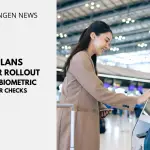EU Confirms Launch Date for Long-Delayed Entry/Exit System

The European Union has officially announced that its long-awaited Entry/Exit System (EES) will go live on 12 October 2025, marking the beginning of a phased rollout over six months.
The EES will introduce biometric passport checks, including fingerprinting and facial recognition for non-EU travellers entering the Schengen Area.
The system is designed to replace manual passport stamping with a fully digital record of travel, helping authorities enforce the 90-day-in-180-day stay rule and improve security by tracking overstays and identifying potential threats.
The launch date means some British holidaymakers travelling during October half-term could be among the first required to submit biometric data at the border.
Despite the new system, traditional passport stamping will continue until the full rollout is completed in early 2026. The EES must be in place before the EU can move forward with the European Travel Information and Authorisation System (ETIAS), the upcoming visa-waiver pre-screening scheme for non-EU nationals. ETIAS is now scheduled to launch in late 2026 and will cost €20 per applicant.
Once operational, EES will connect all Schengen borders to a shared central database, allowing authorities to better monitor and control who is entering and leaving the EU, including UK tourists, business travellers, and other visa-exempt visitors.
However, the mobile app intended to let passengers pre-register information and save time at the border is not expected to be ready by the launch date.
How the Phased EES Rollout Will Work
The EES will apply at all external Schengen borders where non-EU/EEA/Swiss nationals enter or leave the area, such as passengers arriving in France from the US or departing to the UK. This includes airports, ferry ports, and key rail terminals like Eurostar and Eurotunnel.
Countries in the Schengen Area can choose to implement the system fully from day one, across all border points and for all relevant travellers, if they feel prepared. Alternatively, they may opt for a gradual rollout, starting EES checks at selected crossings and expanding over time.
Here’s what the phased approach could look like:
- After 1 month: At least 10% of eligible border crossings should be processed using EES.
- First 60 days: Member states may run EES without collecting fingerprints or facial images to ease the transition.
- After 3 months: EES should be operating at more than one-third of relevant border points.
During this transition period, manual passport stamping will continue and will only stop once EES is fully in place. The system will then take over in tracking entries and exits, helping enforce the 90-days-in-180-days stay rule.
If needed, countries can temporarily suspend EES checks at certain locations, for example, to manage long queues or technical issues.
Do you think the EES will launch this time around? Talk to us in the comment section below. Or if you need more advice on the above, contact us for further travel & immigration advice.
Check out the deals we have found below and tell us your travel plans.
Check out the offers and discounts from:
And because of the pandemic, don’t forget to get your travel insurance, which will cover you for flight disruptions and pandemic related matters.
IaM can help with your visa application to Europe, the United States, the UK & other countries
If you need help with a US visa, a UK Visa, or a visa to Europe, including help with appointment booking obligations, IaM can help. For more information and advice on US immigration, UK immigration law and US visa applications or if you need any help or assistance please, reach out to your Visa Coordinator at IaM.
Some of our posts include affiliate links. If you choose to purchase any of these products, we might get a small commission. For more information, check out our TOS.
- EU Confirms Launch Date for Long-Delayed Entry/Exit System - 26 July 2025
- UK Government Advises Caution Over Thailand-Cambodia Conflict - 25 July 2025
- UK Passport Slips to 6th Place in 2025 Global Rankings - 23 July 2025











